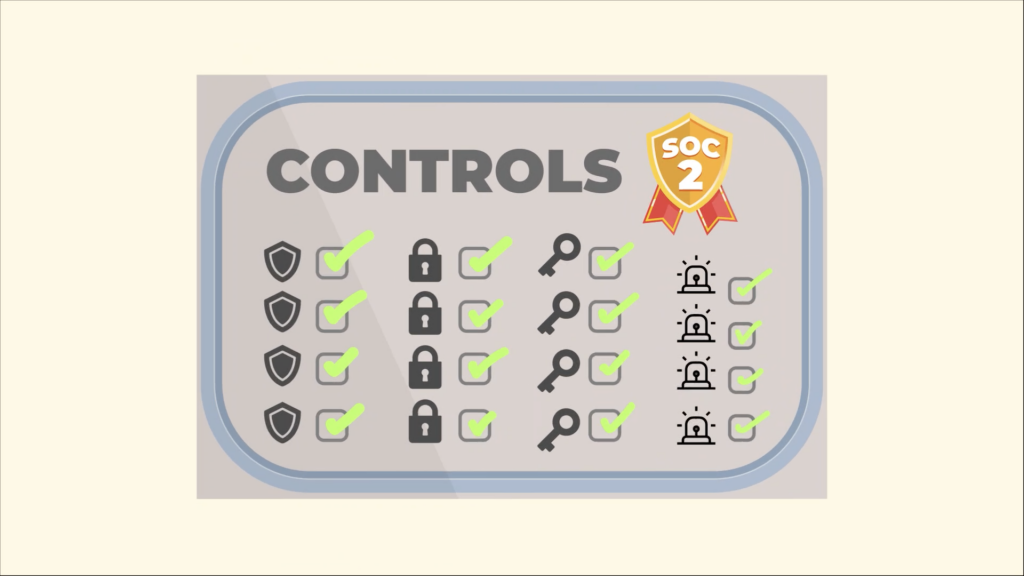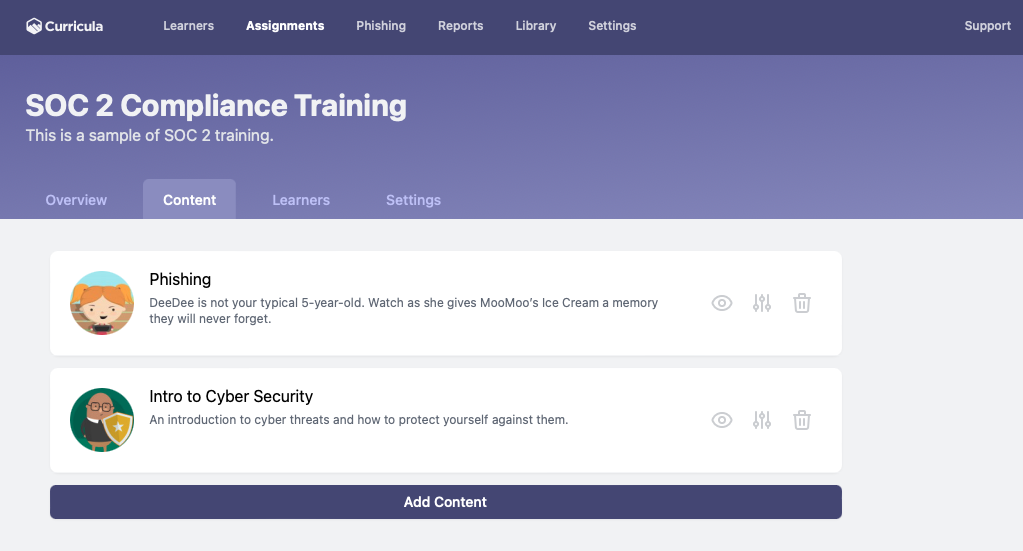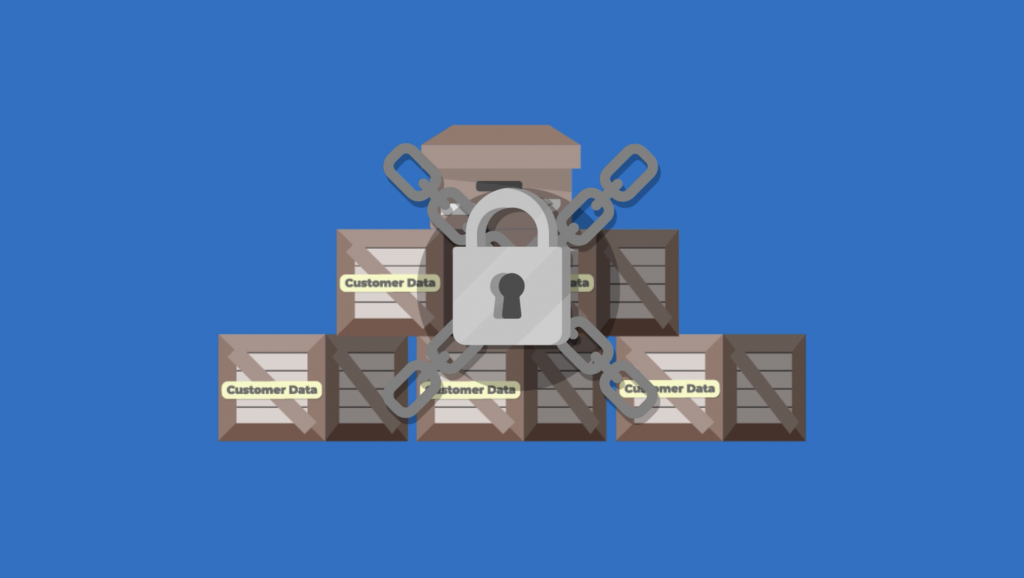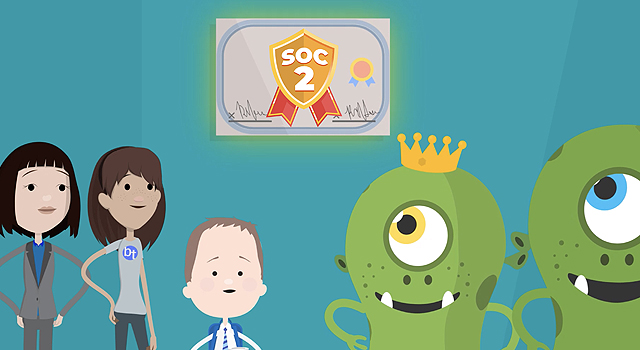SOC 2 is emerging as one of the most common frameworks to transparently demonstrate the security controls your organization follows to protect customer data. There’s a lot of ambiguity about the SOC 2 security awareness training requirementsand what it takes to implement a successful security awareness program. You might have found this blog because you’re searching for what you need to do to successfully navigate your organization through SOC 2 compliance.
I wanted to share our approach here at Curricula on how we help high-growth SaaS companies with their SOC 2 security training requirements. More importantly, I’ll share more about implementing best practices for your security awareness program. I’ll also walk through step-by-step how you can use Curricula for free to launch and manage your SOC 2 employee security awareness training. Lastly, we’ll dig into the requirements that every SOC 2 compliance program needs to achieve. Let’s get started.
Is Security Awareness Training Required for SOC 2 Compliance?
Yes! This is one of the first questions that comes up for any organization pursuing a SOC 2 audit. What is absolutely required for my organization’s security awareness training program to demonstrate SOC 2 compliance?
This is a good place to start because that question varies for different organizations. That’s the beauty of the SOC 2 framework in that you’re in control of the controls (pun intended) that you choose to implement across your organization.
Don’t let a vendor, policy, or auditor force you into a program that doesn’t make sense. Your security program will be validated by a third-party auditor to ensure you have implemented and maintained the controls effectively in the SOC 2 framework.
Security awareness training is a standard control required to be completed as part of your SOC 2 audit. How you approach the employee security training program is up to you. There are several factors that go into how you want to design your security awareness program, but at a minimum:
- It needs to be completed for every employee in scope
- It needs to cover security concepts
- And it needs to be completed every year
Before we start going into the how, I wanted to reaffirm the why. Why is it important to build a foundational level security awareness program for all employees in the scope of your SOC 2 audit?
Well, think about it — your employees are the core of your organization’s operations. Without them, you just have a bunch of computers ‘beep boopin’ at each other.
What is Required for SOC 2 Security Awareness Training?
Now that we understand why we need a security awareness training program as part of SOC 2, what is actually required of your organization to get a positive nod from your auditor?
As stated by the AICPA in the Common Criteria 2.2: “The entity communicates information to improve security knowledge and awareness and to model appropriate security behaviors to personnel through a security awareness training program.”
From a high level, these are the goals to demonstrate a successful security awareness training compliance program for SOC 2:
- Establish your control process for employee security awareness training and build your training plan
- Establish your process and procedures for how your organization will manage a security awareness program
It’s important to remember there’s a lot of flexibility in how you define your security awareness program processes and procedures, including the content that goes into it. Essentially, you’re in charge of security and in turn, have to influence everyone in your organization to take SOC 2 compliance and security seriously. Yes, these are two different things! But remember that just because something is serious, doesn’t mean you can’t have fun doing it.

How to Scope Your SOC 2 Security Awareness Training Policy
Remember: there’s no exact algorithm in the SOC 2 framework for what content needs to be included in your security awareness training program, frequency of training, or quality of that training. That makes this all super easy right? The obscurity is somewhat hilarious and leaves almost all of us confused on what to do next.
Let’s break down the process, starting with your information security policy. Your policy will most likely include a section for security awareness training. This is where your organization will define the high-level objectives for your security awareness program. Your auditors will be confirming you have a process for how and when employees, vendors, and/or contractors receive their training. It is up to you how to define the control, but remember that policies are not procedures.
Let me say that again — policies are NOT procedures.
Policies cover your program vision as a high-level objective statement. Don’t put specific technologies or technical jargon into your policy because those will most likely change over time. Most compliance automation tools will include some default templates for these policies. Ensure that you’re removing all of the extra fluff in there and focus on what’s most important to your organization. Remember the purpose of a security awareness program is to build a security culture and change long-term behavior towards security.
The tricky part is that auditors can have varying perspectives. This means one auditor may view a boring copy and pasted Death by PowerPoint deck as acceptable and other auditors may not. As a former cyber security auditor, one of the best practices I can recommend is to show your work.
That means you should tell a story behind what you are doing and why you are doing it to your auditors. Lay your cards out about how much you care about building a security culture and not just checking the box for compliance. In your narrative, talk about why your security awareness program doesn’t revolve around SOC 2 but, more importantly, how it complements it.
It’s also important not to over-scope the compliance function of SOC 2 and how it relates to security awareness training. This means allowing you to achieve compliance seamlessly without being forced into a rigid mold of maintaining complex controls. Your auditor is there to determine the controls you put in place and ensure they’re operating effectively.

While the goals of a SOC 2 audit are standardized, how your organization executes against those standards are up to you. Essentially, you’re being audited against your internal policies and procedures. As long as you accurately define your plan and follow the effective processes you put in place, you should be able to achieve compliance with the security training requirements of SOC2.
I have seen too many security awareness programs turn into compliance-focused, check the box, panic-for-participation style initiatives. Don’t do that!
I’ve seen training programs get over-scoped in so much detail it was impossible to keep up. For example, over-scoping their policies to sound more like procedures. Then, in turn, driving themselves and their employees mad by forcing an unrealistic approach to training.
Don’t turn security awareness training into a chore instead of a purposeful adventure of learning. Don’t let compliance take over and you’ll save a lot of heartache amongst your employees.
Our Simple Plan to Crush Your SOC 2 Security Awareness Training Compliance Requirements
Alright — you’re ready for it. We’ve learned together about the why and how behind creating a security awareness training program for SOC 2. Now, let’s give you the strategy on how to get there.
We’ve helped countless organizations achieve their SOC 2 compliance training requirements and I’m going to share a summary of how you can do it, too. Remember: SOC 2 gives you flexibility on how you approach your security awareness training program.
1. Sign Up for Curricula Free
It’s free. Really. We designed our platform and plans so that every SaaS startup can jump in right away to build a foundational level security awareness training program for up to 1,000 employees, at no cost. No matter what program, platform, or ideas you have right now, sign up for Curricula free to get started. Seriously.
2. Import Your Employees
If you’re a small startup you can simply import your employees with a CSV or add them manually to the Curricula platform. But our recommendation is to connect to one of our many directory integrations to keep your employees automatically synced and managed in the Curricula platform.
Once your employees are synced, we can determine the content we want to roll out to them as part of your training. Curricula has enrollment rules and capabilities to push various employees into their various required training automatically for you. But for this purpose, we know that every employee needs to complete basic security awareness training for SOC 2, so everything just works out of the box.
3. Activate Your Assignment

Your automatically generated Curricula Assignment will include Phishing and Intro to Cyber Security training courses. These are going to be your starter episodes to get your SOC 2 security training off the ground.
We HIGHLY RECOMMEND adding in our SOC 2 episode as part of your training. This will give every employee a basic understanding of SOC 2, why it’s important for your organization, and teach them some basic definitions about SOC 2 compliance. While not required, we believe giving your employees a background on SOC 2 is beneficial for them to truly understand what their role is to protect customer data.
To add SOC 2 training to your Assignment, simply hit Add Content and pick the episode to add it into your Assignment.

If you’re on a paid plan, you’ll be able to access an entire library of additional episodes that will become more relevant as you are improving the maturity of your security awareness program like password managers, ransomware, incident response, privacy, multi-factor authentication, information security, social engineering, confidential info, and much more.
4. Begin Training!
Once you approve your employee security training content and notification settings, you’re ready to launch your program! By default, Curricula enrolls all employees into your default assignment. This will ensure every time an employee is added to the platform, they’re automatically enrolled into your training program to complete it.
For more on how Assignments work and other FAQs, check out our Support section.
Now you can analyze your dashboards and view completion reports. Remember, this moment is all about hyping employees up to complete their required training. After launching, Curricula will also automatically remind employees that didn’t complete their required training. Use this as an opportunity to reward employees helping your organization become compliant and encourage them to learn more about SOC 2.
5. Download Evidence
Congrats! You’re a security awareness hero for your organization! This is a big milestone and pat yourself on the back for taking the biggest step towards building a remarkable security culture.
Now, you can head over to your Assignment to download compliance reports and training evidence. You have a few options here to download them as a CSV or as a PDF executive summary. We suggest downloading both so your auditor can see a summary and a compliance spreadsheet with all the training details. It’s also good to know that each employee will have a downloadable PDF compliance certificate associated with each completed training episode and Assignment.
6. Level Up Your Security Culture
Your information security program will evolve over time as you mature your overall security program. Regardless, security awareness training never stops and hackers will never give up. There’s so much more to establishing a remarkable security awareness culture than just compliance training. After completing SOC 2, we see most organizations start to level up their security program across the board.
We start seeing organizations move towards including more activities towards building a security culture within just a couple of months. These organizations start to take security more seriously by having fun while learning.
The beauty is that you have all the tools you need inside the Curricula platform to implement when you’re ready for them. We suggest adding phishing simulation training, custom training content, Slack conversations, downloads, and company-wide gamification to your entire program. The more you communicate about security to your employees, the more they will be motivated to help your organization stop hackers right in their tracks.

How do I maintain a SOC 2 Security Awareness Training Program?
SOC 2 is a recurring compliance framework, meaning every year you will have to be re-audited to ensure your security practices stay up to par. So how can you maintain the security awareness processes you set in place?
Here’s what you should be doing for your employee security training to not only meet compliance requirements but also build a culture of security:
- Launch training your employees will enjoy, engage, and have fun with
- Create an open line of communication on what’s required for the SOC 2 audit, how things can improve, and the role every employee plays
- Celebrate team milestones, like passing an audit. Teamwork makes the dream work!
From a reporting standpoint, you’ll retain evidence for every employee. This means you need to deliver, manage, and maintain compliance data for every employee demonstrating they completed their compliance training, even if they leave your organization. When you’re being audited, some employee records will be reviewed at a random sample to see what content they were trained on and the dates of completion.
Having a simple process and platform to document all employee training from the get-go will save you from hours of work explaining the process to your auditors and the headache that comes with it. Good thing Curricula includes a simple LMS to do this for you.
Long term, it’s important to differentiate SOC 2 security awareness training and your company-wide training program. When you’re defining your policy scope, it’s important to close the books on your compliance training, but keep an open book on your security training all year long.
What we mean by this is compliance and security work well together, but they aren’t the same. Don’t overcrowd your security awareness activities as compliance activities. They support each other in many ways, but you’ll find yourself in a documentation/operational nightmare if you try to capture every moment of security education as part of compliance.
Conclusion
The biggest mistake we see with compliance training is making it force you into a compliance-led vs. security-led culture. After all, this is called a security awareness training program, not a compliance training program.
Remember that compliance and security complement each other but aren’t the same thing. If you want to really build a culture around security awareness, there are tons of ways to do this beyond just checking the box for SOC 2.
We’re here to help you on your security awareness journey. If you are only five employees all the way to 500, Curricula defined a path for you to treat security awareness training with the respect it needs to not only meet compliance but also to truly help educate your employees on how to become your best defenders against hackers.
Still have questions about how you can get started with your security awareness program to meet SOC 2? Sign up for your free account and reach out to our team for best practices and advice on how to crush your SOC 2 audit with Curricula





